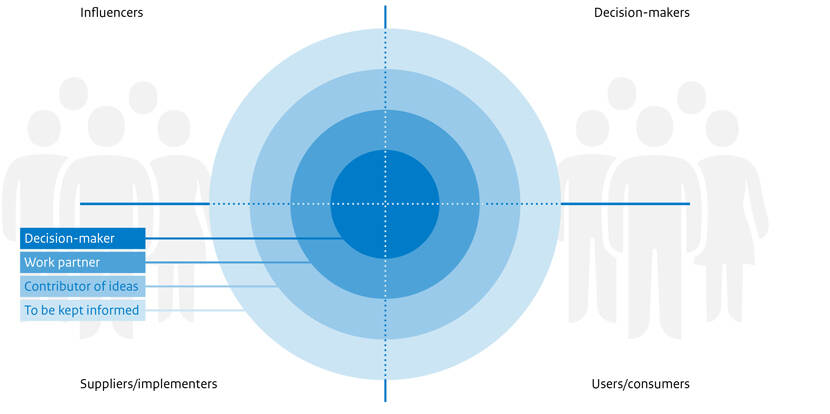Rings of influence: functional roles in a network
What influence do parties in your network have on the project’s development? Do they want to offer input or work with you, or can they be involved in decision-making? Or is it enough for them to be kept informed of what is going on? This analysis provides insight into the current situation: what roles the parties would like to take on and where you think there exists scope for this. It’s the step from ‘what is’ to ‘what should be’ that forms a basis for your strategy.

Tips
- At the top of this picture, write the phase of the project that the analysis relates to.
- An actor analysis and in some cases a force field analysis can help you home in on the principle parties.
- Determining the role that an actor actually has, the role they want to have and their ideal role are three separate analyses. Be sure that you are always aware of which analysis you are carrying out.
- Carry out this analysis again whenever the project enters a new phase.
- You can also put the X and Y axis of your interests and trust matrix behind the rings. This helps clarify the relationship between the actual power an actor has and the role they would like to play.
What the analysis means
- For many communications advisers, this analysis is the step between observation and strategy, because you assign roles and make choices about how you are going to approach the main parties.
- Parties involved in decision-making: these are parties whose decision-making power is derived less from their formal role (‘competent authority’), and more from their decisive influence on the project or its implementation.
- Parties that work with you: these are actors that will actually be working on the project.
- Parties that contribute ideas: these are actors from which the project team would like to have a certain amount of input.
- Parties that should be kept in the loop: these are actors that, in this phase, do not have an active role in the project but should be kept up to date, perhaps because they will become formal decision-makers at a later date (for example, the House of Representatives).
- This is a good place to start if the parties’ expectations do not align with your own notions of what is best.